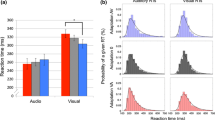Abstract
Assessing intentions, direction, and velocity of others is necessary for most daily tasks, and such information is often made available by both visual and auditory motion cues. Therefore, it is not surprising our great ability to perceive human motion. Here, we explore the multisensory integration of cues of biological motion walking speed. After testing for audiovisual asynchronies (visual signals led auditory ones by 30 ms in simultaneity temporal windows of 76.4 ms), in the main experiment, visual, auditory, and bimodal stimuli were compared to a standard audiovisual walker in a velocity discrimination task. Results in variance reduction conformed to optimal integration of congruent bimodal stimuli across all subjects. Interestingly, the perceptual judgements were still close to optimal for stimuli at the smallest level of incongruence. Comparison of slopes allows us to estimate an integration window of about 60 ms, which is smaller than that reported in audiovisual speech.





Similar content being viewed by others
References
Alais D, Burr D (2004a) No direction-specific bimodal facilitation for audiovisual motion detection. Cog Brain Res 19:195–196
Alais D, Burr D (2004b) The ventriloquist effect results from near-optimal bimodal integration. Curr Biol 14:257–262
Alais D, Carlile S (2005) Synchronizing to real events: subjective audiovisual alignment scales with perceived auditory depth and speed of sound. Proc Natl Acad Sci 102:2244–2247
Andersen TS, Tiippana K, Sams M (2005) Maximum likelihood integration of rapid flashes and beeps. Neurosci Lett 380:155–160
Arrighi R, Alais D, Burr D (2006) Perceptual synchrony of audiovisual streams for natural and artificial motion sequences. J Vision 6:260–268
Arrighi R, Marini F, Burr D (2009) Meaningful auditory information enhances perception of visual biological motion. J Vision 9:1–7
Barraclough NE, Xiao D, Baker CI, Oram MW, Perrett DI (2005) Integration of visual and auditory information by superior temporal sulcus neurons responsive to the sight of actions. J Cog Neurosci 17:377–391
Battaglia PW, Jacobs RA, Aslin RN (2003) Bayesian integration of visual and auditory signals for spatial localization. J Opt Soc Am 20:1391–1397
Bentvelzen A, Leung J, Alais D (2009) Discriminating audiovisual speed: Optimal integration defaults to probability summation when companent reliabilities diverge. Perception 28:966–987
Bidet-Caulet A, Voisin J, Bertrand O, Fonlupt P (2005) Listening to a walking human activates the temporal biological motion area. NeuroImage 28:132–139
Brooks A, Van der Zwan R, Billard A, Petreska B, Clarke S, Blanke O (2007) Auditory motion affects visual biological motion processing. Neuropsychologia 45:523–530
Calvert GA (2001) Crossmodal processing in the human brain: insights from functional neuroimaging studies. Cereb Cortex 11:1110–1123
Clarke JJ, Yuille AL (1990) Data fusion for sensory information processing. Kluwer Academic, Boston
Di Luca M, Machulla TK, Ernst MO (2009) Recalibration of multisensory simultaneity: Cross-modal transfer coincides with change in perceptual latency. J Vision 9:1–16
Efron B, Tibshirani RJ (1993) An introduction to the bootstrap. Chapman and Hall, New York
Ernst MO, Banks MS (2002) Humans integrate visual and haptic information in a statistically optimal fashion. Nature 415:429–433
Ernst MO, Bülthoff HH (2004) Merging the senses into a robust percept. Tends Cog Sci 8:162–169
Garcia JO, Grossman ED (2007) Necessary but not sufficient: Motion perception is required for perceiving biological motion. Vision Res 48:1144–1149
Hiris E, Krebeck A, Edmonds J, Stout A (2005) What learning to see arbitrary motion tells us about biological motion perception. J Exp Psychol 31:1096–1106
López-Moliner J, Soto-Faraco S (2007) Vision affects how fast we hear sounds move. J Vision 6:1–7
Marcell MM, Borella D, Greene M, Kerr E, Rogers S (2000) Confrontation naming of environmental sounds. J Clin Exp Neuropsychol 22:830–864
Massaro DW, Friedman D (1990) Models of integration given multiple sources of information given multiple sources of information. Psychol Rev 97:229–252
Meyer GF, Wuerger SM, Rohrbein F, Zetzsche C (2005) Low-level integration of auditory and visual motion signals requires spatial co-localization. Exp Brain Res 166:538–547
Neri P, Morrone MC, Burr DC (1998) Seeing biological motion. Nature 395:894–896
Saygin AP, Driver J, de Sa VR (2008) In the footsteps of biological motion and multisensory perception. Psychol Sci 19:469–475
Shams L, Ma WJ, Beierholm M (2005) Sound-induced flash illusion as an optimal percept. NeuroReport 16:1923–1927
Shiffrar M, Pinto J (2002) The visual analysis of bodily motion. In: Prinz W, Hommel B (eds) Common Mechanisms in Perception and Action–Attention and Performance XIX. Oxford University Press, Oxford, pp 381–399
Shiffrar M, Lichtey L, Chatterjee SH (1997) The perception of biological motion across apertures. Percept Psychophys 59:51–59
Sugita Y, Suzuki Y (2003) Implicit estimation of sound-arrival time. Nature 421:911
Van der Zwan R, MacHatch C, Kozlowski D, Troje NF, Blanke O, Brooks A (2009) Gender bending: Auditory cues affect visual judgments of gender in biological motion displays. Exp Brain Res 198:373–382
Van Eijk RLJ, Kohlrausch A, Juola JF, Van de Par S (2008) Audiovisual synchrony and temporal order judgments: Effects of experimental method and stimulus type. Percept Psychophys 70:955–968
Van Wassenhove V, Grant KW, Poeppel D (2007) Temporal window of integration in audiovisual speech perception. Neurophychologia 45:598–607
Vatakis A, Spence C (2006) Audiovisual synchrony perception for music, speech, and object actions. Brain Res 111:134–142
Welsh RB, Warren DH (1980) Immediate perceptual response to intersensory discrepancy. Psychol Bull 88:638–667
Wuerger SM, Hofbauer M, Meyer GF (2003) The integration of auditory and visual motion signals at threshold. Percept Psychophys 65:1188–1196
Wuerger S, Meyer G, Hofbauer M, Zetzsche C, Schill K (2010) Motion extrapolation of auditory-visual targets. Information Fusion 11:45–50
Yabe H, Tervaniemi M, Reinikainen K, Näätänen R (1997) Temporal window of integration revealed by MMN to sound omission. Neuroreport 8:1971–1974
Acknowledgments
This work was partly funded by the Portuguese Foundation for Science and Technology (SFRH/BD/36345/2007, PTDC/SAU-BEB/68455/2006, SFRH/BSAB/974/2009) and the Portugal-Spain Actions PT2009-0186 from the Spanish Government and E-134/10 from the Portuguese Conselho de Reitores das Universidades Portuguesas.
Author information
Authors and Affiliations
Corresponding author
Rights and permissions
About this article
Cite this article
Mendonça, C., Santos, J.A. & López-Moliner, J. The benefit of multisensory integration with biological motion signals. Exp Brain Res 213, 185–192 (2011). https://doi.org/10.1007/s00221-011-2620-4
Received:
Accepted:
Published:
Issue Date:
DOI: https://doi.org/10.1007/s00221-011-2620-4




